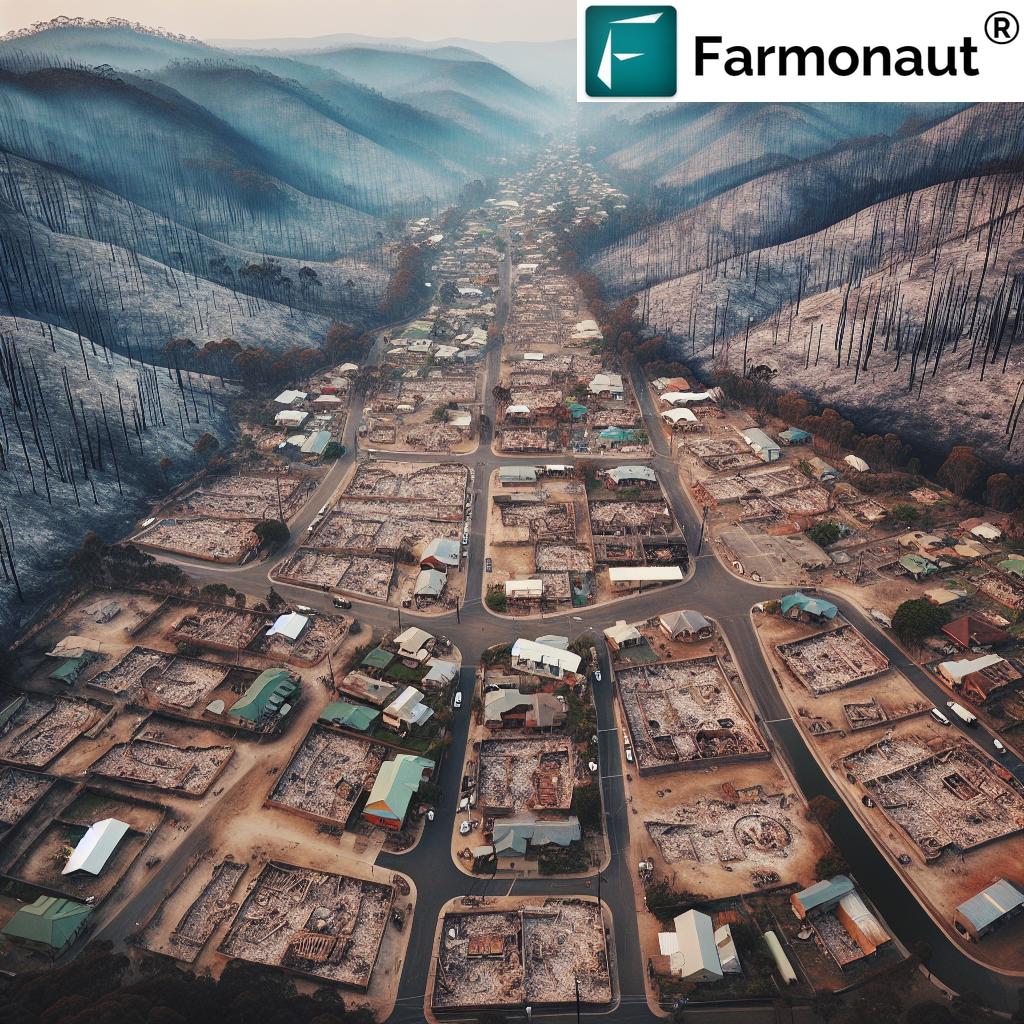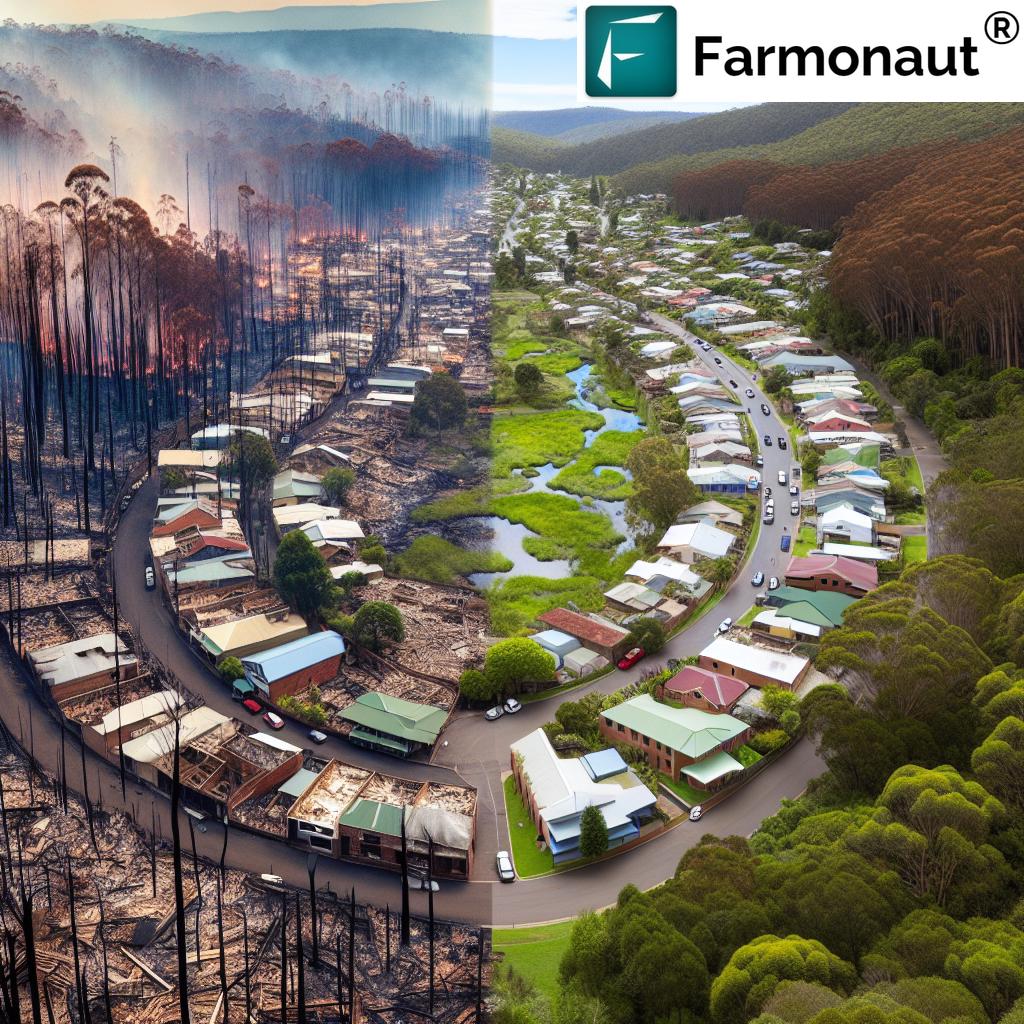Rebuilding Marysville: Lessons in Resilience and Risk from Australia’s Black Saturday Bushfire Recovery
“The 2009 Black Saturday bushfires in Marysville, Australia, destroyed nearly 100% of the town, sparking a complex rebuilding process.”
In the aftermath of one of Australia’s most devastating natural disasters, the small town of Marysville found itself at the epicenter of a national conversation about resilience, risk, and the future of communities in fire-prone areas. As we delve into the complex journey of Marysville’s recovery from the Black Saturday bushfires, we’ll explore the challenges faced by residents, the debates that shaped the rebuilding process, and the lasting implications for disaster preparedness in an era of climate change.
The Day That Changed Everything
On February 7, 2009, a day now etched in Australian history as Black Saturday, Marysville faced an inferno of unprecedented ferocity. As temperatures soared and winds reached hurricane force, a perfect storm of conditions created a firestorm that would forever change the landscape of this picturesque town.
- 39 lives lost in Marysville alone
- 536 out of 550 buildings destroyed
- Entire forests reduced to ash
The devastation was near-total, leaving residents like David Barton, who had confidently assured his wife that “entire towns don’t burn down,” in a state of shock and disbelief. As the flames approached, Barton found himself evacuating stunned neighbors before fleeing with only his dog and a bottle of water – a stark reminder of how quickly life can change in the face of natural disasters.

The Immediate Aftermath: Trauma and Temporary Solutions
In the weeks and months following Black Saturday, Marysville residents grappled with profound loss and the immediate challenges of displacement. The government established Temporary Village, a makeshift community for those who had lost their homes. This close-quarters living arrangement, while necessary, brought its own set of challenges:
- Heightened emotions and frayed nerves
- Frustration with authorities over access restrictions to the town
- The struggle to process grief while living in cramped, temporary conditions
For many, like Barton, the desire to return and rebuild was immediate and powerful. However, this urgency would soon clash with broader concerns about the wisdom of reconstructing a town in such a high-risk area.
The Great Rebuild Debate
As the dust settled and the enormity of the rebuilding task became clear, a crucial question emerged: Should Marysville be rebuilt at all? This debate encapsulated the tension between personal attachment to place and the sobering realities of bushfire risk in Australia.
- Expert panels advised against rebuilding due to inherent vulnerabilities
- Residents and political leaders pushed for reconstruction
- Conflict between emotional ties and scientific risk assessment
Roz Hansen, a planning expert on the government-convened panel, argued strongly against rebuilding, citing Marysville’s location and limited escape routes as insurmountable risk factors. “Bushfire risk is, in my opinion, enough justification to override people’s freedom to live where they please,” Hansen stated, highlighting the ethical dilemma at the heart of the rebuild debate.
“Climate change has increased bushfire risk in Australia, with fire seasons extending by 19% between 1979 and 2013.”
The Path to Reconstruction
Despite the warnings from experts, the emotional and political momentum for rebuilding Marysville proved unstoppable. The state government, led by then-Premier John Brumby, committed to restoring the town’s “commercial heart” and natural beauty. This decision set in motion a complex and often contentious rebuilding process.
- Millions in government funding and public donations
- Implementation of new bushfire building codes
- Tension between preserving town character and enhancing safety
The reconstruction efforts brought new challenges and debates. Many residents, including Barton, found themselves at odds with the vision being implemented by outside consultants and government agencies. The clash between preserving Marysville’s historic charm and creating a more fire-resistant town led to heated discussions and, in some cases, alienation of long-time residents from the rebuilding process.
Lessons in Community Resilience
The Marysville recovery process offers valuable insights into community resilience in the face of disaster. Key lessons include:
- The importance of inclusive decision-making in rebuilding efforts
- The need for long-term psychological support for disaster survivors
- The challenge of balancing safety improvements with community identity
Barton’s experience, which led him to conduct a seven-year ethnographic study on the recovery process, highlights the complex emotional journey of disaster survivors. His concept of “Post-Disaster Attachment Trauma” underscores the deep psychological impact of being separated from one’s home and community in the aftermath of a catastrophe.
Rebuilding for a Fire-Prone Future
As Marysville rose from the ashes, it did so with an eye towards improved fire safety. The rebuilding process incorporated significant changes aimed at making the town more resilient to future bushfires:
- Implementation of stricter bushfire building codes
- Creation of defendable spaces around properties
- Improved water supply systems for firefighting
However, experts like former fire commissioner Greg Mullins remain skeptical about the long-term safety of the town. “They shouldn’t have built it back,” Mullins asserts, pointing to the unchangeable geographical factors that make Marysville inherently vulnerable to bushfires.

The Role of Climate Change
The Marysville story cannot be fully understood without considering the broader context of climate change and its impact on bushfire risk in Australia. As we rebuild and plan for the future, we must grapple with some uncomfortable truths:
- Increasing frequency and intensity of extreme weather events
- Longer fire seasons and more unpredictable fire behavior
- The need for adaptable and responsive urban planning in fire-prone areas
The challenge of balancing personal freedom with public safety becomes even more acute in the face of these changing environmental conditions. As we continue to develop and inhabit areas at risk from natural disasters, the Marysville experience offers both cautionary tales and inspiring examples of human resilience.
The New Marysville: A Town Transformed
Today’s Marysville stands as a testament to both human resilience and the ongoing challenges of living in fire-prone areas. The town has been repopulated, with a mix of returning residents and newcomers drawn by the beauty of the region and the affordability of post-disaster real estate.
- Modern, fire-resistant buildings now dominate the townscape
- Tourism has rebounded, with visitors drawn to the area’s natural beauty
- A renewed focus on community preparedness and fire awareness
However, the scars of Black Saturday remain, both in the landscape and in the collective memory of the community. The challenge now is to maintain vigilance and preparedness without being paralyzed by the fear of another disaster.
Looking to the Future: Lessons for Other Communities
The Marysville experience offers valuable lessons for other communities facing the risk of natural disasters, particularly in the context of climate change:
- The importance of robust disaster preparedness plans
- The need for flexible and adaptive rebuilding strategies
- The value of preserving community ties and identity in the recovery process
As we face an uncertain future, the story of Marysville’s recovery serves as both a warning and an inspiration. It reminds us of the power of community resilience while also highlighting the ongoing challenges of living in harmony with our environment.
The Role of Technology in Disaster Preparedness
As we reflect on the Marysville experience, it’s clear that technology has a crucial role to play in enhancing disaster preparedness and response. While not directly related to bushfire management, innovative agricultural technologies like those offered by Farmonaut demonstrate the potential for satellite-based monitoring and AI-driven insights to revolutionize our understanding and management of natural environments.
- Satellite imagery for real-time monitoring of vegetation and environmental conditions
- AI-powered predictive models for early warning systems
- Data-driven approaches to land management and resource allocation
While these technologies are primarily focused on agricultural applications, the principles of remote sensing and data analysis could potentially be adapted to enhance bushfire prediction and management systems in the future.
Community Engagement and Education
One of the key lessons from Marysville’s recovery is the importance of community engagement and education in disaster preparedness. As we move forward, it’s crucial to:
- Develop comprehensive community education programs on fire safety
- Engage residents in ongoing disaster preparedness planning
- Foster a culture of awareness and readiness in fire-prone communities
By empowering communities with knowledge and involving them in decision-making processes, we can build more resilient towns and cities that are better equipped to face future challenges.
The Ongoing Debate: Development vs. Safety
The Marysville story continues to fuel debates about development in high-risk areas. As climate change increases the frequency and intensity of natural disasters, policymakers and urban planners face difficult questions:
- Should there be stricter regulations on building in fire-prone areas?
- How can we balance individual property rights with community safety?
- What role should government play in managing development in high-risk zones?
These questions have no easy answers, but the Marysville experience provides valuable insights into the complexities of rebuilding and the long-term consequences of our decisions.
Timeline of Marysville’s Recovery and Risk Mitigation Efforts
| Year | Recovery Milestone | Risk Mitigation Measure |
|---|---|---|
| 2009 | Black Saturday bushfires devastate Marysville | Initial emergency response and evacuation |
| 2010 | Temporary Village established for displaced residents | Debris clearing and site preparation for rebuilding |
| 2011 | Rebuilding advisory center opened | Implementation of new bushfire building codes |
| 2012 | First new homes completed | Creation of defendable spaces around properties |
| 2014 | Reopening of key businesses and services | Improved water supply systems for firefighting |
| 2016 | Tourism industry begins to recover | Enhanced community bushfire awareness programs |
| 2019 | 10-year anniversary memorial and reflection | Review and update of town’s bushfire management plan |
| 2021 | Population reaches 453, close to pre-fire levels | Ongoing vegetation management and fire break maintenance |
Conclusion: A Town Forever Changed
The story of Marysville’s recovery from the Black Saturday bushfires is one of resilience, controversy, and ongoing challenges. It serves as a powerful reminder of the destructive force of nature and the complex issues surrounding rebuilding in high-risk areas. As we look to the future, the lessons learned from Marysville will continue to inform discussions about community resilience, disaster preparedness, and sustainable development in the face of climate change.
While technology and improved building practices can mitigate some risks, the Marysville experience underscores the importance of community engagement, adaptive planning, and a realistic assessment of environmental hazards. As we continue to grapple with these issues, we must remain vigilant, prepared, and committed to building safer, more resilient communities for future generations.
FAQ Section
Q: What caused the Black Saturday bushfires in Marysville?
A: The Black Saturday bushfires were caused by a combination of extreme weather conditions, including record-breaking temperatures, strong winds, and prolonged drought. In Marysville, the fire was sparked by a downed power line and quickly spread due to the severe conditions.
Q: How many buildings were destroyed in Marysville during the Black Saturday fires?
A: Out of 550 buildings in Marysville, 536 were destroyed, representing nearly 98% of the town’s structures.
Q: Was Marysville completely rebuilt after the fires?
A: Yes, Marysville was largely rebuilt, but with significant changes. The town now features more fire-resistant buildings and improved safety measures. However, the rebuilding process was controversial and led to changes in the town’s character and demographics.
Q: What measures were taken to make Marysville more fire-resistant?
A: Measures included implementing stricter bushfire building codes, creating defendable spaces around properties, improving water supply systems for firefighting, and enhancing community bushfire awareness programs.
Q: How has climate change affected bushfire risk in Australia?
A: Climate change has increased bushfire risk in Australia by extending fire seasons, creating more extreme weather conditions, and making fire behavior more unpredictable. This has led to more frequent and intense bushfires across the country.
As we conclude our exploration of Marysville’s recovery journey, it’s clear that the challenges of rebuilding and risk mitigation in fire-prone areas are ongoing. The lessons learned from this experience continue to shape discussions about community resilience, disaster preparedness, and sustainable development in the face of climate change. While technology and improved practices can help mitigate some risks, the Marysville story reminds us of the importance of community engagement, adaptive planning, and realistic assessment of environmental hazards.
For those interested in learning more about innovative approaches to environmental monitoring and management, albeit in an agricultural context, we encourage you to explore the solutions offered by Farmonaut. While not directly related to bushfire management, their use of satellite technology and AI-driven insights demonstrates the potential for advanced technologies to enhance our understanding and stewardship of natural environments.
Earn With Farmonaut: Affiliate Program
Earn 20% recurring commission with Farmonaut’s affiliate program by sharing your promo code and helping farmers save 10%. Onboard 10 Elite farmers monthly to earn a minimum of $148,000 annually—start now and grow your income!







